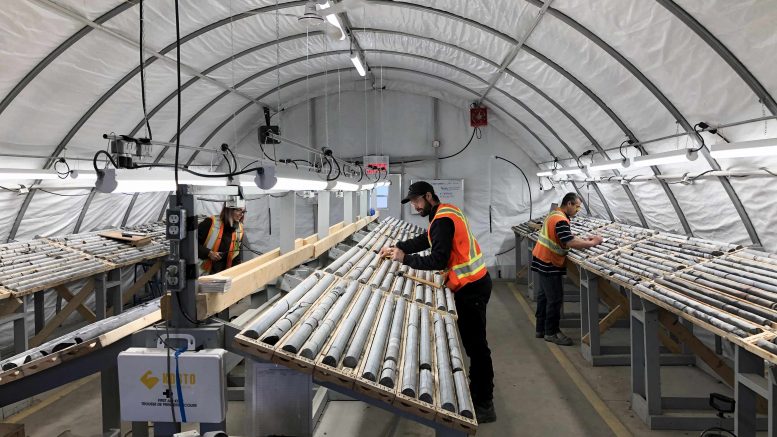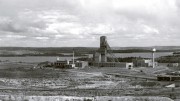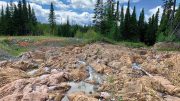Mining companies spend an average of $8.5 billion a year in Quebec, and the industry generates $962 million annually for the provincial government, excluding corporate income taxes, according to the latest report from the Quebec Mining Association. The province has 25 producing mines and 24 exploration projects. Here’s a look at eight companies operating in the mining-friendly province.
Eastmain Resources

The camp at Eastmain Resources’ Clearwater gold property in Quebec, which hosts the Eau Claire deposit. Credit: Eastmain Resources.
Eastmain Resources (TSX: ER; US-OTC: EANRF) is focused on gold exploration in the James Bay region of northern Quebec. Its three main assets are the Eau Claire project, the Eastmain mine project and the Éléonore South joint-venture project, with Newmont Goldcorp and Azimut Exploration.
A preliminary economic assessment (PEA) of its Eau Claire deposit released last year outlined a 12-year mine life producing a total of 950,000 oz. gold at average cash costs of US$486 per oz., and all-in sustaining costs of US$574 per oz. gold.
The mine plan envisioned production from two open pits in the first three years of the operation, with a transition to underground mining in the second year. Preproduction capex is an estimated $175 million, and could be repaid in just over three years. At US$1,250 per oz. gold, the May 2018 PEA forecast an after-tax net present value at a 5% discount rate of $260 million, and a 27% after-tax internal rate of return.
The company is working on preliminary engineering and environmental baseline studies to support future permitting and feasibility study work, and in a recent corporate presentation, said it is targeting first production in 2023.
Eau Claire has measured and indicated resources of 4.29 million tonnes grading 6.18 grams gold per tonne for 853,000 contained oz. gold, and inferred resources of 2.38 million tonnes grading 6.53 grams gold for 500,000 contained oz. gold. Eau Claire is 350 km north of Chibougamau and 50 km from Newmont Goldcorp’s Éléonore gold mine.
The Eastmain mine project contains the past-producing Eastmain mine and has an indicated resource of 899,000 tonnes grading 8.19 grams gold per tonne for 236,500 contained oz. gold, and 579,000 inferred tonnes at 7.48 grams gold for 139,300 oz. gold. Route 167 Nord — built under Quebec’s Plan Nord — provides all-season access to the project.
Eastmain also owns 36.7% of the Éléonore South joint venture, and is the operator. The project sits 5 km south of Newmont Goldcorp’s Éléonore mine, which poured first gold in 2014. Newmont Goldcorp owns 36.7% of the project, and Azimut Exploration, 26.6%.
Eldorado Gold

A drill rig underground at Eldorado Gold’s Lamaque gold mine near Val-d’Or, Quebec. Credit: Eldorado Gold.
Eldorado Gold’s (TSX: ELD; NYSE: EGO) Lamaque mine achieved commercial production in March. The underground mine — near Val-d’Or, 550 km northwest of Montreal — is forecast to process over 500,000 tonnes of ore at an average grade of 7 grams gold per tonne this year, for total production of 100,000 to 110,000 oz. gold (including pre-commercial production), at cash operating costs of US$550 to US$600 per oz. gold sold. The mine has an initial seven-year mine life, with production averaging 117,000 oz. per year.
The company forecasts total capital expenses this year (excluding proceeds from pre-commercial gold sales) will be $80 million to $90 million, including $35 million to $45 million of sustaining capital.
This year the company plans to complete 37,000 metres of exploration drilling to expand resources in the lower part of the Triangle deposit. Triangle is 2.5 km south of the historic Lamaque and Sigma mines, which are also on the property, and produced over 10 million oz. gold.
Triangle, at the eastern end of the prolific Southern Abitibi greenstone belt, is an Archean greenstone-hosted, orogenic lode gold deposit.
Numerous exploration targets occur within the Lamaque operations area, both at depth at the Triangle deposit, and associated with other nearby occurrences. In early September, the company reported drill results from exploration activities over the last year that have expanded high-grade mineralization beyond the 2018 resource model in the lower portion of the deposit, as well as an expanded bulk stockwork zone below 1,250 metres. Intercepts include 19.33 grams gold over 4 metres, 10.72 grams gold over 9 metres, and 12.22 grams over 5 metres.
Lamaque was previously owned by Integra Gold. Eldorado acquired an initial 15% stake in Integra in 2015, and bought the remaining shares in the company in July 2017. Eldorado poured first gold at Lamaque in December 2018.
Galway Metals

Map of Galway Metals’ Estrades polymetallic property in northwestern Quebec. Credit: Galway Metals.
Toronto-based Galway Metals (TSXV: GWM; US-OTC: GAYMF) is advancing its Estrades project, a past-producing, high-grade polymetallic mine in the northern Abitibi of western Quebec, 95 km north of the town of La Sarre.
Breakwater Resources spent $20 million in 1990 developing Estrades, including the installation of a 200-metre-deep by 150-metre-long strike decline, a ventilation raise and associated infrastructure. Production from 1990 to 1991 totalled 174,946 tonnes grading 12.9% zinc, 6.4 grams gold per tonne, 1.1% copper and 172.3 grams silver per tonne. Breakwater closed the mine due to weak metal prices and high contract mining and processing costs.
Galway reported an updated resource estimate for Estrades in September 2018, outlining indicated resources of 1.5 million tonnes grading 3.5 grams gold per tonne, 122.9 grams silver per tonne, 7.2% zinc, 1.06% copper and 0.66% lead, and inferred resources of 2.20 million tonnes grading 1.03 grams gold, 72.9 grams silver, 4.72% zinc, 1.01% copper and 0.29% lead.
The Estrades project hosts three mineralized trends — Estrades, Newiska and Casa Berardi — and features 31 km of strike length. The company consolidated 100% of the Estrades mine and related properties for $1.35 million in August 2016.
This year the company plans to drill 6,000 metres at Estrades. It has completed two geophysical (Titan) surveys over parts of the Estrades and Newiska horizons, and found five major and two minor anomalies.
Last year, it completed a gravity survey over its more than 200 sq. km land position. A preliminary economic assessment is scheduled this year.
Galway’s flagship project, Clarence Stream, is 70 km south–southwest of Fredericton in southwestern New Brunswick. It plans to drill 17,000 metres, or 100 holes, at Clarence Stream this year, and update the resource in 2020.
Management, friends and family own 30% of the company’s shares, and institutions, another 40%. The junior is debt-free.
Maple Gold Mines

Maple Gold Mines’ Douay gold project in Quebec. Credit: Maple Gold Mines.
Vancouver-based Maple Gold Mines (TSXV: MGM; US-OTC: MGMLF) is advancing its 355 sq. km Douay gold project located along the Casa Berardi deformation zone in the Abitibi region of northern Quebec, about a two-and-a-half-hour drive north of Val-d’Or.
Douay is open in multiple directions and has indicated resources of 9.4 million tonnes grading 1.59 grams gold per tonne for 479,000 contained oz. gold, and 84.2 million inferred tonnes averaging 1.02 grams gold per tonne for 2.8 million oz. gold.
The company completed its 6,045-metre winter drill program in April, and reported that 14 of the 15 holes drilled intersected gold mineralization. Highlights included 19 metres grading 2.46 grams gold per tonne in the Porphyry zone, 51 metres of 2.81 grams gold in the 531 Zone and 43 metres of 1.75 grams gold in the Nika zone.
Most of the gold at Douay is associated with a syenite gold system that forms part of a 7 km trend of mineralized zones. These zones are found within the central part of the project’s strike length, which stretches for 55 km along the Casa Berardi deformation zone.
The intrusive-related mineralization style is also present at several other gold deposits that have been found in recent years, such as Canadian Malartic, now owned by Agnico Eagle Mines (TSX: AEM; NYSE: AEM) and Yamana Gold (TSX: YURI; NYSE: AUY), 157 km south of Douay; Osisko Mining’s (TSX: OSK) Windfall project, between Val-d’Or and Chibougamau in the Abitibi region of Quebec; and Alamos Gold’s (TSX: AGI; NYSE: AGI) Young-Davidson mine, 60 km west of Kirkland Lake in northern Ontario.
Douay is 81 km east of Hecla Mining’s (NYSE: HL) Casa Berardi gold mine and 123 km southeast of Detour Gold’s (TSX: DGC) Detour Lake gold mine.
The gold project is also 50 km north of the past-producing Sleeping Giant mine, an orogenic gold deposit, and 66 km south of Selbaie, a volcanogenic massive sulphide (VMS) deposit.
Midland Exploration

Midland Exploration and Osisko Mining’s Eleonore gold project in Quebec’s James Bay region. Credit: Midland Exploration.
Prospect generator Midland Exploration (TSXV: MD) is focused on gold, platinum group elements, and base metals in Quebec, and has various partnerships and option agreements with industry players, including Agnico Eagle Mines, Osisko Mining, Soquem, Abcourt Mines (TSXV: ABI) and the Nunavik Mineral Exploration Fund.
In April, BHP Billiton invested in the junior to support its copper exploration program in northern Quebec, including its Mythril copper-gold-molybdenum silver project in James Bay Eeyou Istchee.
Midland kicked off the first drill campaign at its wholly owned Mythril discovery in February. Drilling is targeting a series of inducedpolarization (IP) anomalies that coincide with showings of copper, gold, molybdenum and silver at surface, as well as float fields, discovered in 2018, and strong copper-molybdenum soil anomalies. The target area of the anomalies is more than 2 km long and hundreds of metres wide, and the initial campaign will consist of nine holes for a 2,200-metre drill program. Mythril is hosted in Archean rocks of the Superior province, and there has been no historic drilling on the project.
The company reported in September that it has found drill targets at its Casault joint-venture with Soquem, 40 km east of the Detour Lake mine, and has completed a 3-D model in Leapfrog to generate six new targets at its Maritime–Cadillac project, just east of the former Lapa mine. Maritime–Cadillac is a joint venture with Agnico Eagle Mines.
Midland has also identified drill targets at its Laflamme joint venture, after a gradient IP survey on the diorite that hosts the Longshot showing discovered earlier this year. Laflamme is a joint venture with Abcourt Mines, and is located in Quebec’s Lebel-sur-Quévillon area.
Midland’s other properties include its wholly owned Heva gold project, 5 km northwest of Agnico Eagle Mines, and Yamana Gold’s Canadian Malartic open-pit mine.
Radisson Mining

Touring the O’Brien gold project in north western Quebec. Credit: Radisson Mining Resources.
Radisson Mining’s (TSXV: RDS; US-OTC: RMRDF) flagship asset is its fully owned O’Brien project. The project is cut by the Larder-Lake–Cadillac Break and hosts the former O’Brien mine — one of the highest-grade gold producers in the Abitibi greenstone belt. It produced 1.19 million tonnes grading 15.25 grams gold per tonne for 587,121 oz. gold from 1926 to 1957. About 90% of historic production came from only three veins, and reached a vertical depth of 1,100 metres.
The project, located halfway between Rouyn-Noranda and Val-d’Or, has indicated resources of 1.91 million tonnes grading 6.67 grams gold per tonne for 408,700 contained oz. gold, and 1.5 million inferred tonnes grading 5.29 grams gold for 255,000 contained oz. gold. The July 2019 estimate used a cut-off grade of 3 grams gold per tonne. The mineral resource area is next to the historic mine.
The deepest level of the resource area reaches 550 metres below surface, and the deposit remains largely untested below, although two historic drill intercepts returned 17.46 grams gold over 1 metre and 13.68 grams gold over 0.3 metre below a depth of 1,000 metres.
In September, the company kicked off a 20,000-metre drill program with two drill rigs at O’Brien. The program should be completed before the end of January.
There are five potential plants for custom milling within 75 km of the project: Agnico Eagle’s LaRonde; Iamgold’s (TSX: IMG; NYSE: IAG) Westwood; Monarch Gold’s (TSX: MOR) Camflo and Beacon; and QMX Gold’s (TSXV: QMX) Lac Herbin.
In addition to O’Brien, Radisson owns 100% of the early-stage Douay property, 35 km southwest of the town of Matagami, and 6 km from Maple Gold’s Douay gold project.
In August, Rob McEwen, through Evanachan, took a 2% stake in the company via a bought-deal private placement.
Troilus Gold

A worker in the core shack at the Troilus gold project. Credit: Troilus Gold.
Toronto-headquartered Troilus Gold (TSX: TLG; US-OTC: CHXMF) is focused on the mineral expansion and potential restart of the former gold-copper Troilus mine. Inmet Mining operated the open-pit mine from 1996 to 2010, and produced more than 2 million oz. gold, and nearly 70,000 tonnes copper.
The 160 sq. km Troilus property is located northeast of the Val-d’Or district, within Quebec’s Frotêt-Evans greenstone belt, near Chibougamau.
In November 2018, the company reported an indicated resource of 3.40 million oz. gold and 231 million lb. copper, held in 121.7 million tonnes grading 0.87 gram gold and 0.086% copper. The project also has inferred resources of 1.02 million oz. gold and 66.2 million lb. copper, in 36.1 million tonnes grading 0.88 gram gold and 0.083% copper.
The company says little exploration has ever been done outside of the main Troilus orebody or below the old resource shells, and kicked off a 40,000-metre drill program in February. Most of the drilling will concentrate around the mine, with the other 20% targeted on regional exploration.
In March, the company reported gold in the southwest footwall zone that ends in mineralization and remains open. The discovery hole (419-092) intersected gold-rich mineralization at a 300-metre depth in the immediate structural footwall to the J zone. The hole returned an intercept of 3 equivalent grams gold over 8 metres and 2.09 equivalent grams gold over 9 metres below the J4 open pit. In early September, the company released more assays from the J zone, including 18.55 equivalent grams gold over 2 metres, within a broader intersection of 1.54 equivalent grams gold over 30 metres.
Troilus tripled its land position north of its property boundary late last year, with the acquisition of 120 sq. km of land owned by Emgold Mining (TSXV: EMR).
Wallbridge Mining

A drill rig at Wallbridge Mining’s Fenelon gold project in northwestern Quebec. Credit: VRIFY.
Wallbridge Mining (TSX: WM) is developing its wholly owned, high-grade Fenelon gold property in northwestern Quebec, proximal to the Sunday Lake deformation zone (SLDF), which hosts the Detour gold mine in Ontario and Balmoral Resources’ (TSX: BAR) gold deposits at Martiniere. The Fenelon property hosts the Discovery zone gold deposit and surrounding 4 km strike length of a gold-hosting secondary splay of the SLDF.
After acquiring the project in 2016, the company completed a prefeasibility study in March 2017, which assessed Fenelon’s economics based on reserves of 28,922 oz. gold within only the top 100 metres of the deposit (6,770 proven tonnes grading 9.3 grams gold per tonne and 89,951 probable tonnes at the same grade). Initial construction capital was an estimated $5.24 million, and the study put total revenues at $47.7 million and total costs of $40.8 million, for pre-tax cash flow of $6.62 million.
The company started dewatering the open-pit and underground mine workings at Fenelon in preparation for a 35,000-tonne bulk sample and underground exploration program in February 2018. Results of the bulk sample were released in May. Stopes in the bulk sample produced 33,233 tonnes of ore with a reconciled average grade of 18.49 grams gold containing 19,755 oz. gold, which were processed at the Camflo mill. Stope grades ranged from 10.94 grams gold to 38.33 grams gold.
So far this year, Wallbridge has completed 42,000 metres of drilling and is on track to complete 70,000 to 80,000 metres by year-end. Recent assay results include 29.58 grams gold over 2 metres in the Cayenne zone, 8.55 grams gold over 2 metres in the Naga Viper zone, 16.33 grams gold over 1 metre in the Area 51 corridor and 5.50 grams gold over 11 metres in the Tabasco zone.
In September, the company said permitting was underway for next year’s second-half startup of a small-scale, 400- to 500-tonne-per-day operation from the already developed areas of the Main Gabbro zones. It also announced that its exploration program would support a maiden resource estimate for the combined Fenelon gold system in early 2021.
In addition to Fenelon, Wallbridge is earning a 100% stake in the Beschefer project, 28 km from Fenelon. Historically, the area has been explored for VMS deposits similar to the Matagami camp and the Selbaie mine, which sits 14 km from Beschefer. Mineralization was discovered at Beschefer in 1995 by BHP Billiton Canada, but the project saw limited exploration, until Excellon Resources (TSX: EXN) got involved in 2011. Excellon drilled 17,000 metres between 2011 and 2013, with high-grade assay results including 55.63 grams gold per tonne over 6 metres, and 13.07 grams gold over 9 metres. The project has seen no exploration since 2013.
Outside Quebec, Wallbridge continues partner-funded exploration on its portfolio of nickel, copper and platinum group metal projects in Sudbury, Ont., with a focus on the high-grade Parkin project.






Be the first to comment on "Quebec Snapshot: Eight companies to watch"